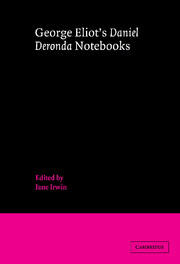PART TWO - THE PFORZHEIMER NOTEBOOKS
Published online by Cambridge University Press: 01 June 2011
Summary
Introduction
In 1976 the notebook known as Pforzheimer MS 707 was published in an edition by William Baker. Thanks to his pioneering efforts, scholars could discover that Gwendolen's name bore several latent meanings, which might be found in George Eliot's memoranda from her reading of Charlotte Yonge's History of Christian Names. Readers could also trace the symbolism of Kabbalistic doctrine in the relation between Ezra / Mordecai and Daniel to its source in excerpts from Christian David Ginsburg's Kabbalah. For both editor and readers, however, the notebook presented a number of puzzles and frustrations. Baker compared ‘George Eliot's notebook of disjointed items’ to ‘the work of a pointillist painter such as Seurat’, but the looked for effects of chromatic luminosity reflected from her pages were too often lost in obscurity. Sympathetic scholars could only surmise the difficulties inherent in Baker's project.
Although Anna Kitchel had edited the Quarry for Middlemarch more than twenty-five years earlier, no other notebooks from the rich hoard of memoranda of George Eliot's reading were then in print. The subsequent publications of George Eliot's ‘Middlemarch’ Notebooks, edited by Pratt and Neufeldt (1979), George Eliot's Blotter, edited by Waley (1980), Wiesenfarth's edition of A Writer's Notebook (1981), and McCobb's study, George Eliot's Knowledge of German Life and Letters (1982), demonstrated that painstaking scholarship could illuminate her patterns of reading: as more notebooks were published, the intelligibility of her memoranda increased. These publications came too late, however, to contribute to Baker's edition of Volume II – MS 711, published in 1980. Although Volume IV – MSS 709 and 710, published in 1985, included ‘Additions and Corrigenda’ for the previous three volumes, editorial practice followed that of Volume I.
Information
- Type
- Chapter
- Information
- George Eliot's 'Daniel Deronda' Notebooks , pp. 215 - 376Publisher: Cambridge University PressPrint publication year: 1996
